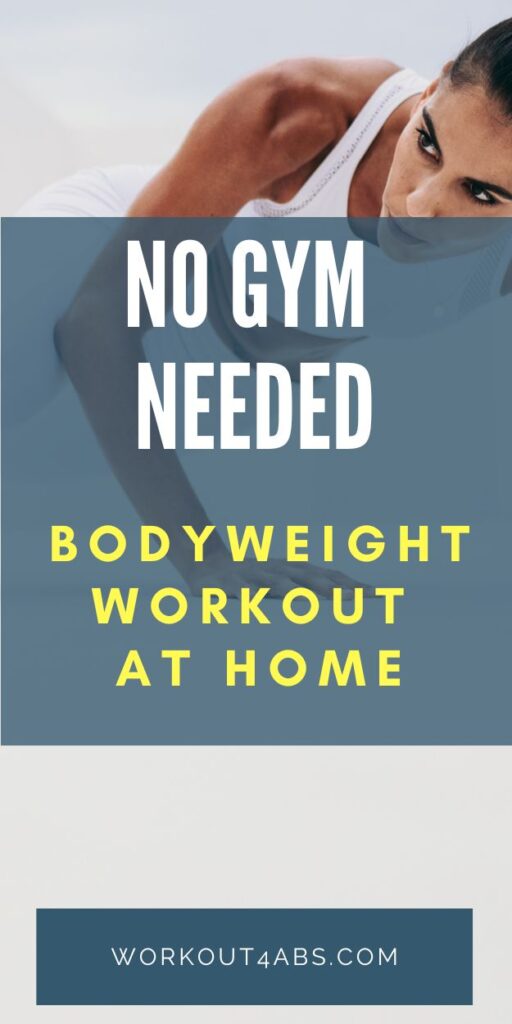Bodyweight workout schedule is the ultimate program that can help you achieve your fitness goals without the need for expensive gym memberships or equipment. This comprehensive guide provides a well-rounded plan designed to build muscle, enhance strength, and improve overall fitness using only your body as resistance. Get ready to transform your physique!
What is a good bodyweight workout schedule plan to build muscle?
A bodyweight workout schedule plan can be an effective way to build muscle if designed properly. Here’s a sample plan that incorporates various exercises to target different muscle groups. Remember to adjust the intensity, sets, and repetitions based on your fitness level and gradually increase the difficulty as you progress:
Day 1: Upper Body
- Push-Ups: 3 sets of 10-15 repetitions
- Diamond Push-Ups: 3 sets of 8-12 repetitions
- Pull-Ups (or assisted pull-ups): 3 sets of 8-12 repetitions
- Chin-Ups (or assisted chin-ups): 3 sets of 8-12 repetitions
- Dips (using parallel bars or chairs): 3 sets of 10-15 repetitions
- Pike Push-Ups (for shoulder strength): 3 sets of 8-12 repetitions
Day 2: Lower Body
- Squats: 3 sets of 10-15 repetitions
- Lunge Variations (forward, backward, or side lunges): 3 sets of 10-12 repetitions per leg
- Glute Bridges: 3 sets of 10-15 repetitions
- Calf Raises: 3 sets of 12-15 repetitions
- Pistol Squats (advanced option): 3 sets of 6-8 repetitions per leg
- Wall Sits: Hold for 60 seconds, repeat 3 times
Day 3: Core and Full Body
- Plank: Hold for 60 seconds, repeat 3 times
- Bicycle Crunches: 3 sets of 10-15 repetitions per side
- Russian Twists: 3 sets of 12-15 repetitions per side
- Mountain Climbers: 3 sets of 10-15 repetitions per leg
- Burpees: 3 sets of 8-12 repetitions
- Handstand Push-Ups (advanced option): 3 sets of 6-10 repetitions
It’s important to note that rest days are crucial for muscle recovery and growth. You can schedule rest days between workout days or incorporate active recovery activities such as light stretching, walking, or yoga on those days.
Additionally, as you progress and become comfortable with these exercises, you can increase the difficulty by adding variations, increasing repetitions, reducing rest time between sets, or incorporating additional challenges like tempo changes or plyometric movements.
Remember to listen to your body, maintain proper form during exercises, and consult with a fitness professional if you have any specific concerns or limitations.
No Gym Needed – The Full Body Bodyweight Workout
What is a good bodyweight workout schedule plan to beginners?
For beginners, it’s important to start with a bodyweight workout schedule plan that focuses on building a foundation of strength and developing proper movement patterns. Here’s a sample plan that introduces basic exercises and allows for progression over time:
Day 1: Full Body
- Bodyweight Squats: 2 sets of 10-12 repetitions
- Push-Ups (from knees or against a wall): 2 sets of 8-10 repetitions
- Assisted or Chair Dips: 2 sets of 8-10 repetitions
- Plank: Hold for 30-45 seconds, repeat 2 times
- Glute Bridges: 2 sets of 10-12 repetitions
- Walking Lunges: 2 sets of 8-10 repetitions per leg
Day 2: Rest or Light Activity
Day 3: Full Body
- Step-Ups (using a sturdy step or platform): 2 sets of 8-10 repetitions per leg
- Incline Push-Ups (hands on a bench or elevated surface): 2 sets of 8-10 repetitions
- Bodyweight Rows (using a suspension trainer or a sturdy horizontal bar): 2 sets of 8-10 repetitions
- Plank: Hold for 30-45 seconds, repeat 2 times
- Reverse Lunges: 2 sets of 8-10 repetitions per leg
- Bird Dogs: 2 sets of 8-10 repetitions per side
Day 4: Rest or Light Activity
Repeat the cycle, gradually increasing repetitions, sets, or difficulty of exercises as you feel more comfortable and stronger. As a beginner, it’s important to focus on proper form and technique rather than pushing yourself to the limit. Gradually progress over time to avoid injury and allow your body to adapt to the exercises.
Remember to warm up before each workout with light cardio, and cool down with some light stretching afterwards. It’s also advisable to consult with a fitness professional or a trainer to ensure proper form and receive personalized guidance based on your individual needs and goals.
How to Create the Perfect Workout Plan | Beginner Guide
Can you build muscle mass with bodyweight exercises?
Yes, it is possible to build muscle mass with bodyweight exercises. While traditional weightlifting and resistance training with weights are commonly associated with muscle building, bodyweight exercises can be equally effective, especially for beginners or those without access to gym equipment. Building muscle mass primarily relies on two factors: progressive overload and adequate nutrition.
Progressive overload: To build muscle, you need to challenge your muscles progressively over time. This means gradually increasing the difficulty or intensity of your exercises. With bodyweight exercises, you can achieve progressive overload by increasing the number of repetitions, sets, or the difficulty of the exercise variations. For example, you can progress from standard push-ups to decline push-ups or from regular squats to pistol squats.
Adequate nutrition: Building muscle mass also requires proper nutrition to provide your body with the necessary nutrients for muscle growth and repair. Ensure you are consuming enough protein to support muscle synthesis, along with a balanced diet that includes carbohydrates and healthy fats.
By combining progressive overload through bodyweight exercises with a well-balanced diet, you can stimulate muscle growth and build muscle mass. It’s important to note that the rate of muscle gain may be slower compared to traditional weightlifting, but consistent training and a progressive approach can still yield significant results over time. Additionally, bodyweight exercises offer the advantage of improving functional strength, mobility, and stability, which are valuable for overall fitness.
If this article on the bodyweight workout schedule and would like to keep it close to you at any time, just save this pin to your Pinterest Board.

Home › Workout Schedule ›Bodyweight Workout Schedule